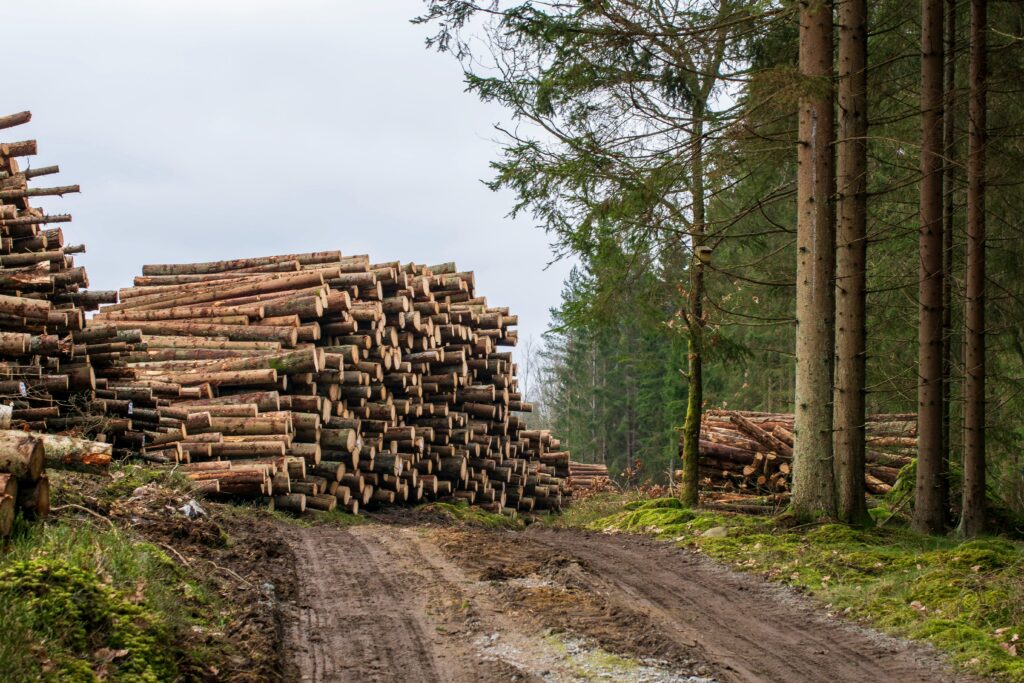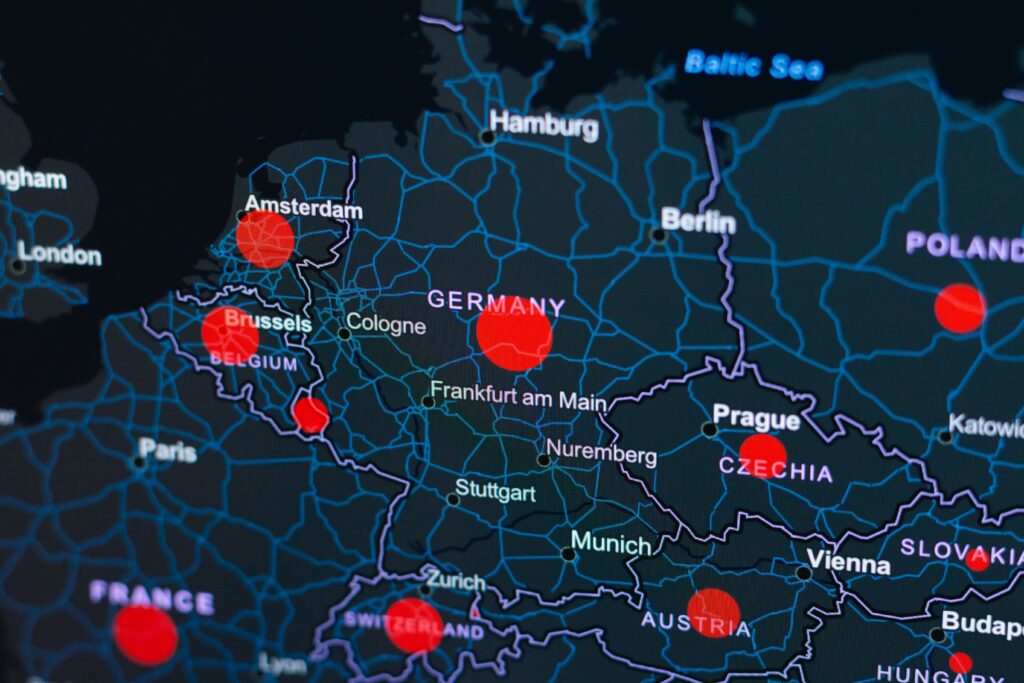The EU Deforestation Regulation (EUDR) is a binding legal framework that prohibits the trade of products linked to deforestation and forest degradation within or from the European Union. Set to apply from 30.12.2025 for large companies and 30.06.2026 for small and micro-enterprises, the EUDR marks a significant shift in global supply chain regulation.
This article explains what the EUDR is, why it matters, which products are covered, and what businesses need to do to comply. It is especially relevant to companies involved in agriculture, forestry, retail, manufacturing, and logistics that operate in or trade with the EU. Understanding the EUDR is essential for legal compliance, operational risk management, and long-term ESG performance.

Understanding the EUDR: Core Goals and Legal Context
This section introduces the legal foundation and strategic purpose of the EUDR, outlining why the regulation was introduced and how it fits into the EU’s broader sustainability agenda.
EUDR as a Legal Instrument
The EU Deforestation Regulation, officially Regulation (EU) 2023/1115, entered into force on 29 June 2023. As a regulation, it is directly applicable across all EU member states without the need for national transposition. The enforcement phase begins on 30.12.2025 for large businesses and on 30.06.2026 for small and micro-enterprises.
Main Objectives of the EUDR
The EUDR was created to address the environmental and human rights impacts of deforestation-driven trade. Its primary goals reflect the EU’s commitment to responsible sourcing, climate action, and sustainable supply chains. The regulation sets out four core objectives:
- Prevent the entry of deforestation-linked goods into or out of the EU market.
- Promote deforestation-free and legally produced commodities.
- Support the EU’s climate, biodiversity, and human rights commitments.
- Enforce transparency, traceability, and accountability in global supply chains.
The regulation is part of the EU Green Deal and complements other ESG policies such as the Corporate Sustainability Due Diligence Directive (CSDDD) and the Corporate Sustainability Reporting Directive (CSRD).
Who Must Comply with the EUDR Regulation
The EUDR clearly defines the roles and responsibilities of businesses involved in placing, importing, exporting, or trading relevant products on the EU market.
Operators and Traders
Operators are entities that place products on the EU market for the first time or export them from it. Traders are those who further distribute these products within the EU without being the initial importers or exporters. Both categories are legally responsible for ensuring that all relevant products comply with the EUDR before being placed or exported.
For large companies, the compliance deadline is 30.12.2025. From this date, they must be able to demonstrate that covered products are deforestation-free, legally produced, and supported by a complete due diligence statement submitted through the EU’s centralized information system. Operators and traders must also collect and retain sourcing and traceability data in case of inspections or audits.
SME Exemptions and Transitional Period
Small and micro-enterprises benefit from a deferred compliance deadline of 30.06.2026. While SME traders are not required to conduct full due diligence, they must verify that their suppliers (typically larger operators) have done so. All companies, regardless of size, must retain relevant documentation and respond to official inquiries when requested.
Which Products and Commodities Are Covered
This section outlines the specific commodities and products regulated under the EUDR, along with relevant classification systems and exemptions.
The Seven High-Risk Commodities
The regulation applies to the following commodities due to their strong links to deforestation:
- Cattle (beef, hides, leather products).
- Cocoa (beans, powder, paste, chocolate).
- Coffee (roasted, decaffeinated, husks).
- Oil palm (palm oil, kernel oil, derivatives).
- Rubber (raw rubber, tires, belts, hoses).
- Soya (soybeans, meal, oil, cakes).
- Wood (timber, pulp, paper, furniture).
These commodities are selected based on scientific assessment of deforestation impact and EU market relevance.
Covered Products Based on CN Codes
Products are identified using the EU’s Combined Nomenclature (CN) codes listed in Annex I of the regulation. If a product’s CN code is not listed, it is not subject to the EUDR. Verification against official customs classification databases is recommended for clarity.
Exemptions and Special Cases
Recycled products, certain forms of packaging, and materials at the end of their lifecycle may be excluded unless they are traded as independent products containing regulated commodities.
Key Compliance Requirements under EUDR
To place or export any product regulated under the EUDR, businesses must meet three essential legal conditions. These requirements form the core of the regulation and are designed to ensure that commodities entering or leaving the EU market contribute neither to deforestation nor to legal non-compliance in their countries of origin.
The Three Core Conditions
Before accessing the EU market, companies must demonstrate that their products meet the following three conditions. Each is mandatory and applies equally to all commodities and derived products covered by the regulation:
- Deforestation-free: Products must not originate from land that has been deforested or subject to forest degradation after 31.12.2020. This includes both direct sourcing and upstream activities.
- Legally produced: The product must comply with all applicable laws in the country of origin. These include environmental regulations, labor rights, land tenure, and protections for indigenous and local communities.
- Due diligence statement: A formal declaration must be submitted through the EU’s centralized information system before the product can be placed on or exported from the EU market.
Failure to meet any of these conditions makes the product ineligible for trade within the EU. Compliance is not optional and must be proven through verifiable data, proper documentation, and timely submission of the required statement.
Due Diligence: The Backbone of EUDR Compliance
Due diligence is the central mechanism for ensuring compliance with the EUDR. It is a mandatory process that all operators and large traders must perform before placing products on the EU market or exporting them. The goal is to confirm that goods are deforestation-free, legally produced, and traceable to their source. This section outlines what due diligence involves and how companies can assess and manage compliance risks.
What Due Diligence Involves
To meet EUDR requirements, companies must implement a structured due diligence system. This system must cover a range of actions designed to collect and verify information across the supply chain. The process includes the following key steps:
- Collecting detailed product and supply chain data.
- Identifying the country of origin and geolocation of production plots.
- Verifying compliance with applicable laws and confirming deforestation-free status.
- Submitting due diligence statements for each product batch through the EU system.
- Storing all relevant documentation for a minimum of five years.
Each of these steps is legally required and must be completed before the product enters or exits the EU market. The effectiveness of due diligence depends on the quality and traceability of the data collected at every stage.
Risk Assessment and Mitigation
As part of due diligence, companies must assess the risk that their products may be linked to deforestation or legal non-compliance. This involves evaluating several factors that can influence risk levels, including:
- The classification of the source country or region as low, standard, or high risk.
- The complexity and transparency of the supply chain.
- The credibility and completeness of supplier documentation.
- The presence of indigenous communities or vulnerable ecosystems in the production area.
If the result of the risk assessment shows more than a negligible risk, the company must apply mitigation measures before placing the product on the market. These may include collecting additional documents, conducting on-site audits, or using satellite verification tools. All mitigation actions must be documented and reviewed annually to maintain compliance readiness.
Geolocation and Traceability Requirements
Geolocation is one of the most technically demanding and legally critical aspects of EUDR compliance. It plays a central role in proving that commodities are sourced from land unaffected by deforestation after the official cut-off date. Without precise geolocation data, companies cannot demonstrate traceability or verify deforestation-free claims, making this requirement a non-negotiable condition under the regulation.
Why Geolocation Is Essential
To confirm that products are deforestation-free, companies must provide accurate geolocation coordinates for every plot of land involved in the production of covered commodities. These coordinates must be submitted in the WGS84 format and serve as the evidentiary basis for satellite-based verification by regulatory authorities. This allows enforcement bodies to cross-check land-use history and ensure compliance with the 31.12.2020 cut-off date.
The following data must be collected and linked to each relevant plot:
- GPS coordinates of plots.
- Type of commodity and production method.
- Size of the land and supplier identity.
- Time of harvesting or production.
This information forms the backbone of the due diligence process and must be securely stored and made available for audits or inspections upon request. Without verified geolocation data, products cannot be considered compliant with EUDR requirements.
Practical Challenges and Solutions
Implementing geolocation at scale often presents operational and logistical difficulties, especially when sourcing from rural areas or working with smallholder producers. These challenges must be anticipated and addressed early in the compliance process.
Common issues include:
- Limited access to GPS tools and mobile devices among smallholder farmers.
- Lack of digital literacy or training in geospatial data collection.
- Informal or undocumented land ownership.
- Shared use of agricultural plots by multiple households or producers.
- To overcome these obstacles, companies can adopt the following strategies:
- Providing training and tools to suppliers.
- Using mobile apps and satellite monitoring platforms to capture location data.
- Partnering with cooperatives or local organizations for data collection support.
- Investing in scalable digital systems that integrate with compliance workflows.
Addressing these challenges proactively helps ensure that traceability data is accurate, verifiable, and audit-ready. Companies that build robust geolocation systems not only reduce compliance risk but also gain long-term advantages in supply chain transparency and sustainability reporting.

Simplified Due Diligence for Low-Risk Areas
To streamline compliance while maintaining environmental integrity, the EUDR introduces a risk-based approach to due diligence. This system allows for simplified procedures when sourcing from countries or regions identified as low risk. While the fundamental compliance principles remain unchanged, the administrative burden may be reduced in certain cases. Understanding how this classification works is essential for strategic sourcing and risk management.
Risk Classification by the EU
The European Commission will assess and classify countries and subnational regions based on the likelihood of deforestation and legal non-compliance. This classification affects the depth and type of due diligence companies must perform.
There are three official risk levels:
- Low risk: Minimal deforestation activity and strong alignment with legal and environmental standards.
- Standard risk: The default level, requiring full due diligence procedures.
- High risk: Areas with elevated concerns, where enhanced due diligence is mandatory.
The Commission is expected to publish the first list of risk classifications no later than 30.06.2025. Until then, all countries should be treated as either standard or high risk, and companies are advised to apply full due diligence measures during this interim period.
Minimum Requirements Still Apply
Even when sourcing from a low-risk area, companies are still required to meet specific baseline obligations under the EUDR. These core requirements ensure traceability and accountability across all supply chains:
- Collection of geolocation data for every plot of land involved in production.
- Submission of due diligence statements through the EU’s centralized system.
- Secure storage of all supporting documentation for at least five years.
These obligations apply regardless of risk level and serve to uphold the integrity of the regulation. Companies should not treat low-risk classification as an exemption, but rather as an opportunity to streamline processes without compromising compliance quality.
Enforcement and Penalties for Non-Compliance
Enforcement under the EUDR is designed to ensure that companies meet their legal obligations through meaningful oversight and dissuasive penalties. Regulatory control becomes effective from 30.12.2025 for large companies and from 30.06.2026 for small and micro-enterprises. Compliance failures can lead to serious legal, financial, and reputational consequences. This section outlines how supervision will be implemented and what penalties may apply.
Supervisory Mechanisms
To ensure consistent enforcement across the EU, each Member State must designate competent authorities responsible for monitoring compliance. These bodies play a critical role in reviewing documentation, verifying supply chain data, and responding to external complaints.
Their responsibilities include:
- Conducting risk-based inspections and on-site audits.
- Reviewing due diligence statements and supporting evidence.
- Investigating complaints from third parties, such as NGOs or affected communities.
- Accessing and analyzing geolocation data and sourcing records upon request.
Authorities are empowered to perform checks at any point in the supply chain and may take immediate action if they detect irregularities. Their oversight helps maintain market integrity and builds public trust in the system.
Sanctions and Legal Consequences
When violations occur, Member States are obligated to apply penalties that are effective, proportionate, and dissuasive. The regulation allows national authorities to impose a wide range of legal and financial consequences depending on the severity of non-compliance.
Possible penalties include:
- Fines of up to 4% of a company’s total annual EU turnover.
- Confiscation of non-compliant products and any profits gained from their sale.
- Temporary or permanent bans on placing products on the EU market.
- Exclusion from public procurement procedures and funding opportunities.
- Public disclosure of the company’s name and details of the violation on EU platforms.
These measures aim to prevent repeat offenses and ensure that companies take their obligations seriously. Transparency around enforcement actions also creates a level playing field for businesses that invest in full compliance.
Practical Steps to Prepare for EUDR Compliance
Achieving compliance with the EUDR requires a structured, proactive approach. Companies must assess their operations, engage supply chain partners, and invest in systems that support traceability and documentation. Preparation should be completed before the regulation becomes enforceable – by 30.12.2025 for large companies and by 30.06.2026 for small and micro-enterprises. This section outlines the key steps businesses should follow to meet the legal obligations and reduce operational risk.
Step-by-Step Action Plan
Building an internal compliance roadmap is essential to navigate EUDR requirements efficiently. The following actions represent the minimum steps businesses should take to ensure readiness:
- Identify relevant products in the company’s portfolio and map supply chains down to the farm or forest level.
- Engage with suppliers to understand their capacity and willingness to meet EUDR standards.
- Collect and verify geolocation data and documentation proving legal compliance and deforestation-free status.
- Set up or upgrade IT systems capable of handling data collection, verification, and storage.
- Submit due diligence statements before placing any covered products on the EU market or exporting them from the EU.
Completing these steps ahead of the compliance deadline helps minimize business disruption and supports long-term ESG alignment.
Supplier Engagement and Capacity Building
Suppliers, especially in high-risk or resource-constrained regions, are critical to successful implementation. Without their cooperation, data collection and verification become unreliable. Companies should focus on building supplier understanding and operational capacity.
Recommended actions include:
- Training suppliers on EUDR compliance obligations and documentation procedures.
- Providing user-friendly materials such as checklists, mobile apps, and toolkits in local languages.
- Offering incentives or support to adopt traceability tools and sustainable practices.
- Participating in or initiating industry collaborations to harmonize expectations and avoid duplication.
Strong supplier relationships not only reduce compliance risks but also enhance transparency and resilience across the value chain.
Technology and Infrastructure Investment
Digital tools play a vital role in enabling traceability, automating documentation, and integrating compliance with existing workflows. Companies should evaluate their current systems and invest in scalable infrastructure that supports EUDR requirements.
Useful technologies include:
- Traceability platforms that support multi-tier supply chain mapping.
- Satellite-based forest monitoring to verify land-use history and compliance with the 31.12.2020 cut-off date.
- Blockchain- or QR-based systems for secure, transparent data transmission.
- Integration with ERP, procurement, and legal compliance systems for centralized oversight.
These investments enhance operational efficiency and audit readiness, and position companies for future regulatory developments in the ESG landscape.
Aligning EUDR with Broader ESG and Due Diligence Frameworks
Compliance with the EUDR does not exist in isolation. Companies already subject to other EU sustainability directives can benefit from integrating EUDR processes into broader ESG strategies. Aligning due diligence systems helps reduce duplication, streamline reporting, and ensure consistency across legal frameworks. This approach is especially valuable for businesses preparing for the EUDR enforcement deadlines of 30.12.2025 for large companies and 30.06.2026 for small and micro-enterprises.
EUDR, CSRD, and CSDDD Synergies
The EUDR shares common principles with other EU sustainability laws, such as the Corporate Sustainability Reporting Directive (CSRD) and the Corporate Sustainability Due Diligence Directive (CSDDD). Harmonizing reporting processes across these frameworks creates operational efficiencies and ensures a coherent ESG narrative.
Key synergies include:
- Centralized data collection on supply chain practices and environmental impact.
- Alignment of risk assessment methodologies for social and environmental due diligence.
- Unified reporting structures that meet both EUDR and CSRD disclosure requirements.
- Enhanced credibility with stakeholders through transparent and consistent documentation.
By integrating EUDR procedures into existing ESG governance systems, companies can reduce regulatory fragmentation and build a more resilient compliance architecture.
Role of External Consultants
Many companies, particularly those with complex or global supply chains, may benefit from expert support when implementing EUDR requirements. External consultants offer specialized knowledge and objective insight that can accelerate compliance and minimize risk.
Consultants can assist with:
- Mapping supply chain risks and interpreting applicable local laws.
- Setting up data management systems and conducting staff training.
- Performing independent audits and readiness assessments.
- Advising on integration strategies with CSRD, CSDDD, and other frameworks.
Engaging consultants early in the process allows companies to anticipate challenges, close compliance gaps, and prepare effectively before the regulation takes effect. This is especially important given the strict deadlines and extensive documentation requirements set by the EUDR.

How eudr.co Provides Tools That Simplify EUDR Compliance
Our platform EUDR.co is built to guide businesses through every step of the certification journey from collecting geolocation data to submitting Due Diligence Statements through the EU’s TRACES-NT system. We combine automation, traceability, and legal alignment to simplify the complex technical and documentation demands of the regulation.
We designed our solution specifically for the challenges of EUDR compliance. Unlike generic ESG tools, our platform is tailored to the unique requirements of regulated commodities like timber, coffee, cocoa, palm oil, and soya. We support full traceability from production plot to product shipment, helping companies create a verifiable chain of custody that meets EU expectations.
We understand that global supply chains are complex and often involve smallholder producers in high-risk regions. That’s why we provide flexible tools for multilingual collaboration, secure document storage, and seamless integration with existing ERP and procurement systems. Whether you’re managing a single commodity or a multi-country sourcing network, our system scales with your operations.
We believe EUDR compliance is more than a checkbox – it’s an opportunity to build trust, strengthen sustainability credentials, and reduce long-term risk. With eudr.co, companies can move beyond spreadsheets and manual processes toward structured, audit-ready workflows that save time, cut costs, and ensure full legal alignment with the EU’s deforestation-free trade rules.
Conclusion
The EUDR is more than a regulatory hurdle. It is a powerful tool that demands transparency, traceability, and accountability from all businesses trading with the EU. By requiring proof of deforestation-free and legal sourcing, the regulation is reshaping how global supply chains operate.
For professionals, clients, and decision-makers, preparing for the EUDR is not optional. It is a strategic move that protects market access, mitigates risk, and builds long-term brand integrity. Businesses that act early, invest in systems, and support their suppliers will be better positioned to lead in the era of responsible trade.
FAQ
1. What is the main goal of the EUDR regulation?
The EUDR aims to eliminate products linked to deforestation and forest degradation from EU trade. It ensures that goods placed on or exported from the EU market are deforestation-free, legally produced, and traceable. This supports environmental sustainability, legal compliance, and human rights protection in global supply chains.
2. Which products are covered under the EUDR?
The regulation targets seven high-risk commodities: cattle, cocoa, coffee, oil palm, rubber, soya, and wood. It also covers many derived products such as leather, chocolate, furniture, and paper. Specific products are listed in Annex I of the regulation using EU customs codes.
3. When does the EUDR come into effect?
The EUDR enforcement begins on 30.12.2025 for large companies and on 30.06.2026 for small and micro-enterprises. Businesses must be ready to comply with all due diligence, traceability, and reporting requirements by those dates to maintain legal access to the EU market.
4. What is required for geolocation compliance?
Geolocation compliance involves providing precise GPS coordinates for the land where commodities were produced. This data must be detailed, accurate, and tied to a specific production period. It allows authorities to verify deforestation-free claims using satellite imagery and monitoring tools.
5. What are the penalties for non-compliance with the EUDR?
Penalties include fines of up to 4% of EU turnover, confiscation of goods, market access bans, and public disclosure of violations. These sanctions are designed to discourage non-compliance and uphold the regulation’s environmental and legal goals.
6. How can companies prepare for EUDR compliance?
Businesses should start by mapping their supply chains and identifying affected products. They must engage suppliers, collect geolocation and legal data, and implement traceability systems. Submitting due diligence statements and maintaining records are also essential steps.
7. Is due diligence required for low-risk countries?
Yes, but the process is simplified. Companies sourcing from low-risk countries still need to collect geolocation data and submit compliance statements. However, risk assessments and mitigation measures may be waived unless specific concerns arise.


